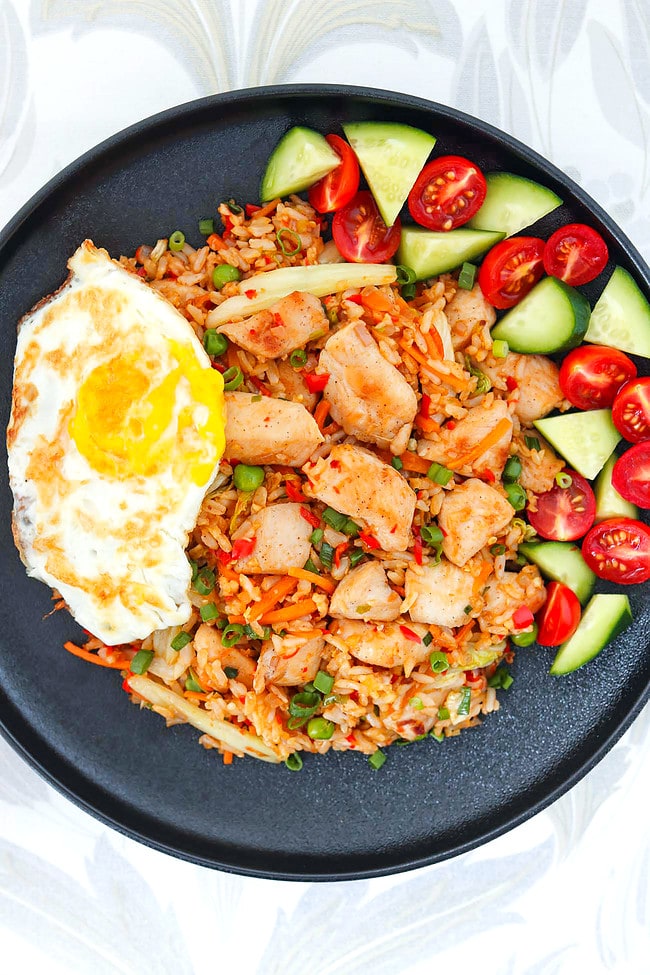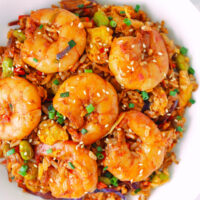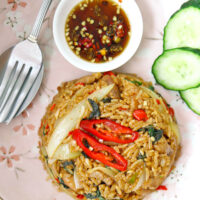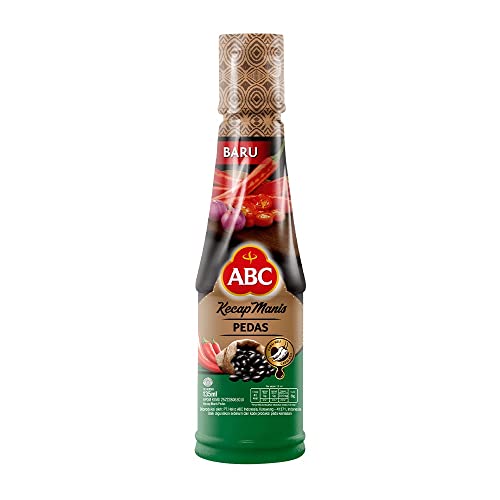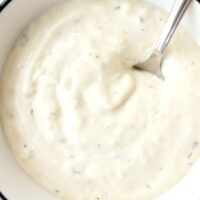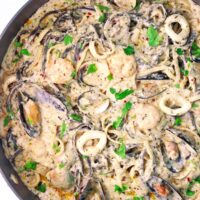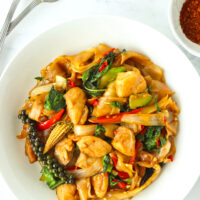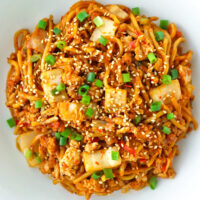Chicken Nasi Goreng Recipe
This post contains affiliate links.
This Chicken Nasi Goreng recipe, also known as Indonesian chicken fried rice, is made with tender chicken, fresh veggies and fried eggs. Easy to make with simple ingredients in 30 minutes, it features a sweet and savory flavor profile and bold flavors that transport your tastebuds to Indonesia. Prepare a big batch in advance to enjoy throughout the week!
What Is Chicken Nasi Goreng?
Nasi Goreng is a signature dish in Indonesia and is enjoyed by both tourists and locals. The literal translation of nasi goreng means “fried rice” in Indonesian and Malaysian languages, and that’s exactly what is it!
Nearly every country has its own variation of fried rice. However, what sets nasi goreng apart from other recipes is its sauce. Sweet, savory and umami all at once, it is made with kecap manis. This is a type of sweet soy sauce used in traditional Indonesian cuisine. It caramelizes as it cooks and gives the rice a deep brown color and an extra-rich flavor.
Although nasi goreng is almost always served topped with fried eggs, it can be found in many different variations. For example, chicken and shrimp are common protein additions and a variety of vegetables can be included.
No matter how you serve it, nasi goreng is tantalizingly delicious and surprisingly simple to make!
Why This Recipe Works
- Nutritious. Containing carbs, fats, protein, nutrients and fiber, chicken nasi goreng is a well-rounded, comfort food dish that satisfies your tastebuds and keeps you full.
- Versatile. You can easily mix and match any ingredients you have on hand to make this Indonesian fried rice suit your preferences and needs. You can also enjoy it for breakfast, lunch or dinner any season of the year!
- Customizable. Switch out the chicken for tofu or tempeh to make it vegetarian/vegan. Or use beef, pork or shrimp – they all taste great in this Indonesian fried rice!
- Meal Prep Friendly. Leftovers store well, which means you can prepare a big batch to reheat for quick, easy meals throughout the week.
Ingredients and Substitutions
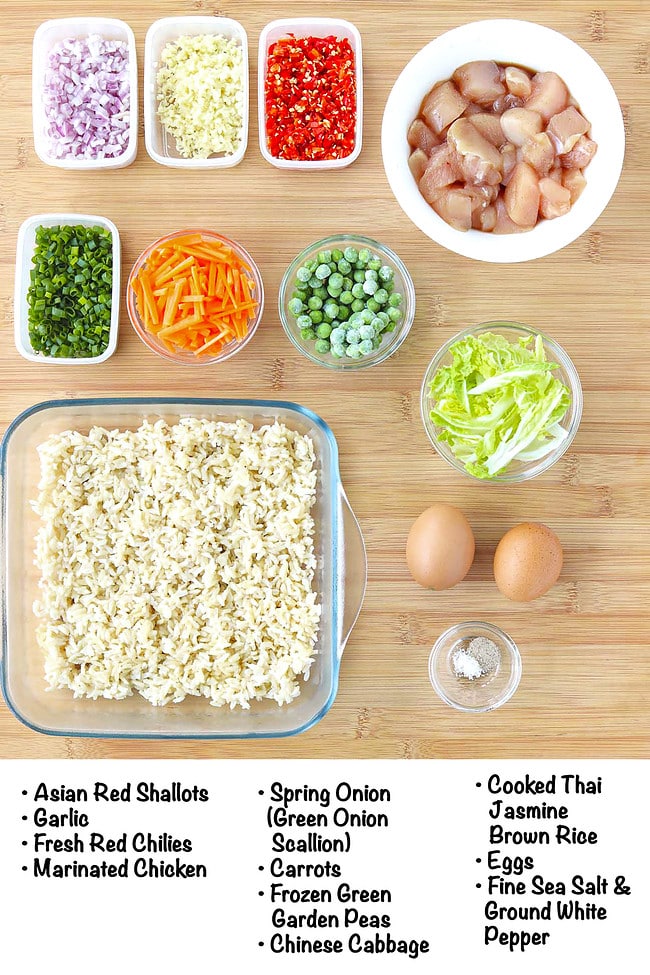
Don’t be intimidated by its Indonesian roots! Most of the items needed to make this chicken nasi goreng recipe are easy to find at most local grocery stores. I’ve provided substitutes for the rarer items. Here are the key ingredients you’ll need:
Chicken
- Chicken: I recommend using boneless, skinless chicken breast. However, boneless chicken thighs could be used too.
- Fish Sauce: This provides a salty, umami flavor and helps tenderize the chicken to keep it juicy.
- Light Soy Sauce. I recommend using a Thai light soy sauce since it is less salty than Chinese or Japanese soy sauces. However, any low sodium light soy sauce can be used.
- Peanut Oil: To cook the chicken and to prevent it from sticking to the pan. Feel free to use any neutral cooking oil with a high smoke point.
Nasi Goreng
- Asian Red Shallots: Smaller in size than Western shallots, this aromatic creates a pungent, sweet base of flavor. Regular shallots or red onion can be substituted.
- Garlic: For the best results, use whole fresh cloves instead of the pre-minced bottled garlic or garlic paste.
- Red Chilies: I use the Thai Bird’s Eye variety, but any type of hot red chilies will do. Use more or less to suit your heat level preference.
- Spring Onion: Also known as scallion and green onion. We will include both the green and white parts but add them to the wok at different times.
- Carrot: Slice them into fine matchsticks. If preferred, pre-cut matchstick carrots from the supermarket can be used for convenience.
- Chinese Cabbage: Also known as Napa cabbage or wombok. Substitute with regular cabbage if unavailable.
- Frozen Green Peas: Make sure to thaw them first!
- Peanut Oil: A little goes a long way to stir-fry the ingredients.
- Eggs: These are fried separately and added on top.
- Cooked Thai Jasmine Brown Rice: I like to use Thai jasmine brown rice, but white jasmine rice or any long-grain cooked rice will do.
Sauce
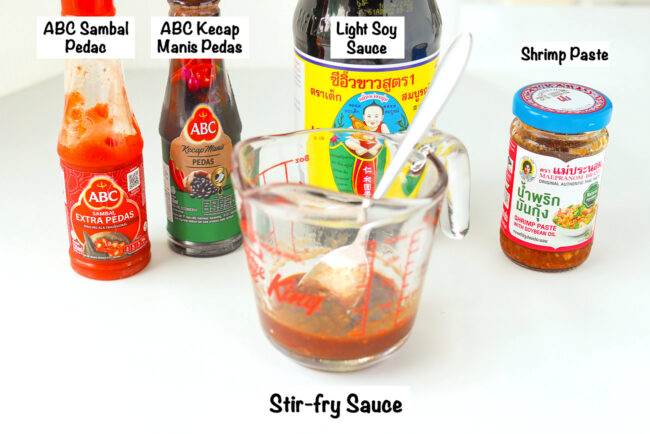
- ABC Kecap Manis Pedas: This is a thick, sweet Indonesian soy sauce that can be found online and in most Asian grocery stores. I use a spicy (‘pedas’) version but any thick sweet dark soy sauce will work, including Thai sweet dark soy sauce.
- ABC Sambal Extra Pedas. An Indonesian chili paste made with chilies, garlic, tomatoes, sugar and spices. You’ll also sometimes find it containing additional aromatics such as lemongrass and galangal. I prefer to use the spicier version. However, this Indonesian fried rice sauce can be made with sambal oelek or any chili garlic sauce or paste available to you. It will still taste great!
- Light Soy Sauce: For more savory umami flavors to season the rice.
- Shrimp paste with Soybean Oil: Known by many different names like ‘gapi’, ‘kapi’, ‘trassi’ and ‘belacan’, shrimp paste is typically added to nasi goreng to enhance the flavors. I like to use a spicy Thai shrimp paste with soybean oil which comes in small glass jars. It is less potent than any of the aforementioned shrimp pastes and adds more spicy delicious notes to this chicken nasi goreng. Any type of shrimp paste will work for this recipe though. Feel free to use whichever type you have on hand or can easily purchase.
Scroll down to the recipe card to find the full ingredients list.

How to Make This Easy Chicken Nasi Goreng Recipe
- Fry the eggs. Heat peanut oil in a small frying pan, and crack the eggs in once at a time. Cook just until the whites are set. Then flip the eggs over and continue to cook until your desired doneness is achieved. Season with salt and pepper, and transfer to a plate.
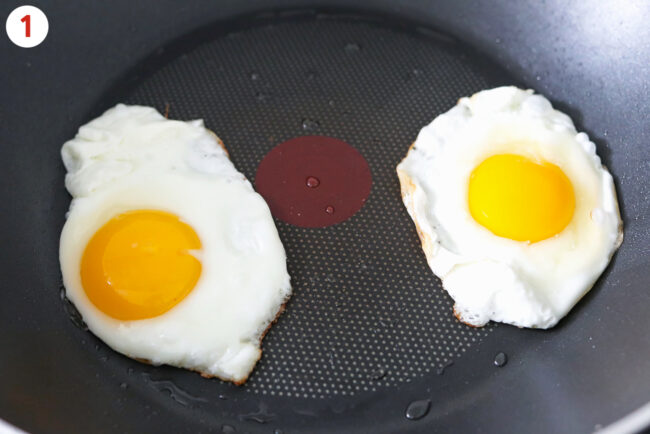
- Cook the chicken. Heat more oil in a large nonstick wok over high heat. Add the marinated chicken and spread the pieces out in an even layer. Sear them for a few seconds. Then, stir-fry until the chicken is fully cooked. Transfer to a clean bowl and set aside.
- Stir-fry the aromatics. Heat the remaining oil in the same wok and add the shallots and spring onion white and light green parts. Stir-fry until they are just beginning to soften. Add the garlic and chilies and cook until fragrant.
- Stir-fry the veggies. Next, add the carrots, cabbage and peas. Stir-fry just until they soften a little.
- Add the cooked chicken. Toss briefly to combine.
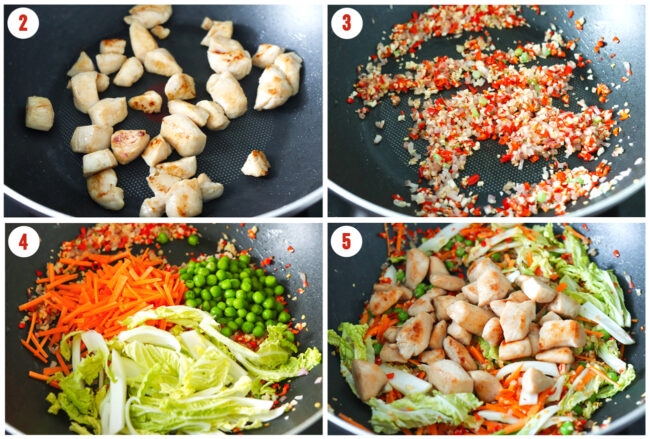
- Stir-fry the rice and sauce. Add the cooked rice and pour the sauce on top. Stir-fry for a minute, until every rice grain is evenly coated in the sauce and the rice caramelizes a little.
- Season and add spring onion. Season with salt and white pepper to taste and toss through the spring onion dark green parts.
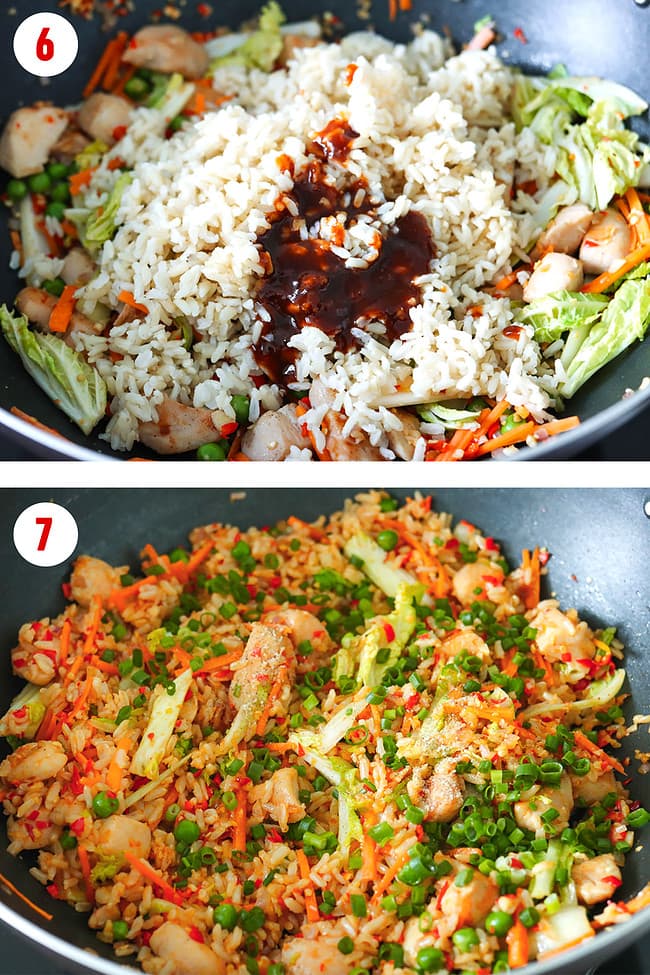
- Serve. Divide evenly onto plates. Garnish with more spring onion dark green parts and top with a fried egg and a drizzle of sambal if desired. Finally, add your sides and toppings of choice and enjoy warm!

Full recipe instructions and nutrition information is in the recipe card below.
Cook’s Tips
- Use day-old rice. Cold, old rice is firmer and drier than freshly cooked rice. As a result, it absorbs the sauce well and “fries” in the wok whereas fresh rice will steam and become mushy.
- Mise en place. This Indonesian fried rice recipe cooks very quickly. So, prepare all your ingredients in advance and have them close by before you begin cooking.
- Cook over high heat. Too low heat will cause the rice to steam instead of fry and become mushy.
Variations
One of the beautiful things about this nasi goreng recipe is that you can include a wide variety of ingredients and use up any extra veggies you have on hand! Feel free to experiment with different ingredients and add-ins.
For example, you can:
- Add extra spices. Turmeric, coriander and red pepper flakes are common additions that can add a bit of punchy, earthiness to the dish.
- Include lime juice. Splashing a few drops of lime juice into the wok at the end is an easy way to brighten some of the heaviness from the fats, creating a vibrant, well-rounded meal.
- Add crunch. Top off your plate with fried shallots or onions for a bit of extra flavor and texture.
- Incorporate shrimp. Most traditional nasi goreng recipes include fresh or dried shrimp. They’re a great way to add even more protein!
- Make it vegetarian/vegan. Swap the chicken out for crispy pan-fried tofu cubes or tempeh, and use a vegetarian fish sauce or more light soy sauce in its place. You can leave out the shrimp paste and add more kecap manis. Alternatively, use a Thai vegan shrimp paste which is made from fermented bean protein and similar to dark red miso paste – which can also be used instead.
- Use a different protein. Swap the chicken for shrimp/prawns, sliced pork fillet (tenderloin) or beef flank or skirt steak.

Serving Suggestions
Nasi Goreng is often served as a breakfast dish with a side of vegetables like fresh tomatoes and cucumbers. With the addition of chicken, this recipe is a complete, filling meal on its own. However, it also pairs well with sides like:
FAQs
If you plan to make this recipe ahead of time, I recommend leaving out the eggs until just before serving. Once cooled, it can be transferred to an airtight container and stored in the fridge for up to 4 days.
Yes. Again, I recommend omitting the egg until just before serving. However, the rice can be stored in the freezer for up to 1 month.
Sure, to make this Indonesian fried rice recipe with chicken gluten-free, opt for gluten-free kecap manis and use a gluten-free soy sauce or tamari.

MADE THIS RECIPE? If you make this recipe, leave a comment below and let me know how you liked it! Take a photo and tag it with @thatspicychick on Instagram and hashtag it #thatspicychick and I’ll be sure to share your masterpiece!
STAY CONNECTED! You can also follow me on Pinterest, Facebook or Instagram. Sign up for my email list to get my latest recipe in your inbox weekly!
More Fried Rice Recipes
Chicken Nasi Goreng Recipe
This Chicken Nasi Goreng recipe, also known as Indonesian chicken fried rice, features a sweet and savory flavor profile and made with fresh veggies, tender chicken and fried eggs. Easy to make, it comes together with simple ingredients for bold flavors that transport your tastebuds to the island of Indonesia.
- Prep Time: 20
- Cook Time: 10
- Total Time: 30 minutes
- Yield: 2 1x
- Category: Dinner
- Method: Stir-fry
- Cuisine: Indonesian
Ingredients
Chicken:
- 230 grams / 8.11 ounces Chicken Breast, boneless, skinless – cleaned, pat-dried, cut into bite-sized pieces
- ⅛ TSP Fine Sea Salt (or use ¼ TSP Kosher Salt)
- ⅛ TSP ground White Pepper
- 1 TSP Fish Sauce
- 1 TSP Light Soy Sauce (preferably a Thai one, or use any low sodium light soy sauce)
- 1 TSP Peanut Oil (or any neutral flavored cooking oil with a high smoke point)
Sauce:
- 15ml/ ≈ 1 TBSP ABC Kecap Manis Pedas (spicy Indonesian thick dark soy sauce, or use regular spice kecap manis – note 1)
- 15ml / ≈ 1 TBSP ABC Sambal Extra Pedas (or use any sambal or other chili garlic sauce – note 2)
- ½ TBSP Light Soy Sauce
- 1 TSP Shrimp Paste with Soybean Oil (or use any type of shrimp paste – note 3)
Nasi Goreng:
- 45 grams / 2-3 small Asian Red Shallots (substitute with regular shallots or red onion) – finely chopped
- 25 grams / 5-6 Garlic cloves – minced
- 35 grams / 9-10 fresh Red Chilies (Thai Bird’s Eye or any other small hot red chilies – note 4*), to taste – finely chopped
- 20 grams / 1 medium Spring Onion (Scallion/Green Onion) – chopped, white and light green parts separated from the dark green parts
- 50 grams / ½ small Carrot – peeled, cut into matchsticks
- 50 grams / ½ cup Chinese Cabbage (Napa cabbage/wombok) – sliced
- 50 grams / about ¼ cup frozen Green Peas, thawed
- 1 TSP + ½ TBSP Peanut Oil
- 2 large Eggs
- 240 grams / 1.5 cups cooked Thai Jasmine Brown Rice, day-old, chilled (100 grams / 3.5 ounces uncooked weight – note 5)
- ⅛ TSP Fine Sea Salt (or ¼ TSP Kosher Salt), to taste
- ⅛ TSP ground White Pepper, to taste
- To Serve (optional): Fried egg, sambal to drizzle over the egg and/or nasi goreng, cucumber slices, halved cherry tomatoes (or sliced tomato), fried shallots, Indonesian shrimp crackers, etc.
Instructions
Prep:
- Marinate the chicken: Cut the chicken into bite-sized pieces and add to a medium bowl. Add the ground white pepper, fine sea salt, fish sauce and light soy sauce. Mix well to combine and set asides.
- Make the sauce: In a small measuring cup (for easier pouring) or bowl, mix together the kecap manis, sambal, light soy sauce and shrimp paste until combined well.
- Prepare the rest of the ingredients: Chop the shallots, garlic, red chilies, spring onion (separate the white and light green parts from the dark green parts), carrot, and Chinese cabbage as indicated in the ‘ingredients’ section. Measure out the frozen peas in a microwave safe bowl and heat on high in the microwave for 30-40 seconds to thaw.
Chicken Nasi Goreng:
- Fry the eggs: In a small frying pan (or use the same wok you’ll use for the fried rice), heat 1 teaspoon peanut oil over medium heat. Once hot, crack the eggs into the pan. Cook for 2-3 minutes or until the whites have set. Flip and cook for another 1-2 minutes or until the yolk is set or cooked to your liking. Remove to a plate and season with salt and pepper if desired. Set aside.
- Cook the chicken: Heat 1 teaspoon oil in a large nonstick wok over high heat. Add the marinated chicken pieces and immediately spread out the pieces in the wok. Allow to sear for 40 seconds, then stir-fry for 1-2 minutes or until just cooked. Transfer to a clean bowl and set aside.
- Stir-fry the aromatics: Heat the remaining ½ TBSP of oil in the wok over high heat. Add the shallots and spring onion white and light green parts. Stir-fry for 30 seconds until starting to soften. Add the garlic and chilies and stir-fry for 20-30 seconds until fragrant.
- Stir-fry the veggies: Add the carrots, cabbage and green peas and stir-fry for 30-40 seconds until just starting to soften.
- Add the chicken, rice and sauce: Add the chicken and toss briefly to combine. Then add the cooked rice and pour the sauce on top. Stir-fry for 1 minute, until every rice grain is evenly coated in the sauce and caramelizes a little.
- Season and toss through spring onion: Season with fine sea salt and ground white pepper. Toss through most of the spring onion dark green parts (reserve some for garnish) and switch off the heat.
- To Serve: Divide evenly onto plates and sprinkle with the reserved spring onion. Top each plate with a fried egg and drizzle sambal on top of the egg if desired. Serve immediately with cucumber slices, halved cherry tomatoes and/or fried shallots and shrimp crackers if desired.
Notes
- ABC Kecap Manis Pedas. Kecap manis is a sweet dark thick Indonesian soy sauce. It is available at Asian supermarkets and online. I use a spicy (‘pedas’) version but any thick sweet dark soy sauce will work, including Thai sweet dark soy sauce.
- ABC Sambal Extra Pedas. Sambal is an Indonesian chili sauce/paste made with chilies, garlic, tomatoes, sugar and spices. It’s sometimes made with other aromatics such as lemongrass and galangal too. I used a spicy version of ABS brand sambal, which is both sweet and a little spicy. Look for ABC brand sambal in an Asian supermarket. Substitute with sambal oelek or any chili garlic sauce/paste that is easily available to you.
- Shrimp Paste with Soybean Oil. Known by many different names like ‘gapi’, ‘kapi’, ‘trassi’ and ‘belacan’, shrimp paste is typically added to nasi goreng to enhance the flavors. I like to use a spicy Thai shrimp paste with soybean oil which comes in small glass jars. It is less potent than any of the aforementioned ones and adds more spicy delicious notes to this Chicken Nasi Goreng recipe. Any type of shrimp paste will work for this recipe though. Use whichever type you have on hand or can easily purchase.
- Fresh Red Chilies. Adjust the quantity to taste based on your heat level preference. Leave them out if you prefer your nasi goreng to be more sweet than spicy.
- Thai Jasmine Brown Rice. White jasmine rice or any cooked long grain rice will work. Day-old or two day-old cooked chilled rice works best for making fried rice and won’t become mushy.
- Nutritional Information: Nutritional information provided is only for the Chicken Nasi Goreng with a fried egg and 5 grams of sambal extra pedas topping for each serving. It does not include any of the other optional serving items as the type and amounts you use may vary based on your preference.
- Meal prep option and reheating leftovers. Double the ingredients by clicking the ‘2x’ button at the top of the recipe card to make four 4 servings. Use a large enough wok or deep skillet to cook the fried rice or cook in two batches. Divide into meal prep containers or any airtight sealed container and store in the fridge for up to 4 days. Reheat the fried rice on high in the microwave for 1.5 to 2 minutes or until hot throughout. I recommend frying the eggs and topping on the reheated fried rice just before eating.
- See the ‘Variations’ section in the post above if you’d like to customize this recipe.
Nutrition
- Serving Size: 1/2 of recipe
- Calories: 586
- Sugar: 12.5g
- Sodium: 3007.8mg
- Fat: 19g
- Saturated Fat: 4.3g
- Unsaturated Fat: 10.4g
- Trans Fat: 0g
- Carbohydrates: 63g
- Fiber: 6.2g
- Protein: 40.9g
- Cholesterol: 272.3mg
This post may contain affiliate links. We are a part of the Amazon Services LLC Associates Program, an affiliate advertising program designed to provide a means for us to earn a small commission (at no extra cost to you) by linking to Amazon.com and affiliated sites. The nutritional information provided is approximate and can vary based on several factors. It should only be used as a general guideline. For more information, please see our Disclosure.

